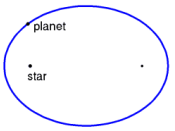Kepler's Laws of Planetary Motion:
Kepler's First Law (1609): The orbit of a planet about a star is an ellipse with the star at one focus.
Kepler's Second Law (1609): A line joining a planet and its star sweeps out equal areas during equal intervals of time.
Kepler's Third Law (1618): The square of the sidereal period of an orbiting planet is directly proportional to the cube of the orbit's semimajor axis.
Kepler's first law(the law of ellipses): Simply it is the all planets orbits the sun in a path which looks like an ellipse - explains that planets are in the suns orbit and their shape looks like an ellipse. Example: An ellipse can easily be constructed using a pencil, two tacks, a string, a sheet of paper and a piece of cardboard. Tack the sheet of paper to the cardboard using the two tacks. Then tie the string into a loop and wrap the loop around the two tacks.
Take your pencil and pull the string until the pencil and two tacks make a triangle (see diagram at the right). Then begin to trace out a path with the pencil, keeping the string wrapped tightly around the tacks. The resulting shape will be an ellipse. An ellipse is a special curve in which the sum of the distances from every point on the curve to two other points is a constant. The two other points (represented here by the tack locations) are known as the foci of the ellipse. The closer together which these points are, the more closely that the ellipse resembles the shape of a circle. In fact, a circle is the special case of an ellipse in which the two foci are at the same location.
Kepler's Second Law(the law of equal areas): It...


